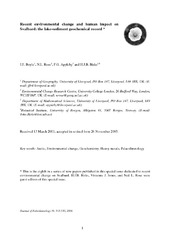Recent environmental change and human impact on Svalbard: the lake-sediment geochemical record
Peer reviewed, Journal article
Permanent lenke
https://hdl.handle.net/1956/2484Utgivelsesdato
2004Metadata
Vis full innførselSamlinger
Originalversjon
https://doi.org/10.1023/b:jopl.0000022549.07298.6eSammendrag
As part of a broader investigation into recent environmental change on Svalbard, the inorganic geochemical record of six lake-sediment cores was analysed. The major temporal trends in sediment elemental composition are driven by variations in two contrasting sediment components, both derived from catchment soils: (1) mineral matter, and (2) soil organic matter (SOM), enriched in Fe and Mn oxides and heavy metals. Two environmental impacts are recorded in most or all of the lake sediment sequences. An up-core increase in organic matter can be partly attributed to diagenetic effects, but also requires an enhanced supply of SOM relative to mineral matter. In addition, the central and southern sites all show a ca. 1970 event characterised by an enhanced mineral matter accumulation rate. This requires either an enhanced allochthonous supply or an enhanced mobilisation of littoral sediments. In either case a regional-scale driving force, such as a shift in climate, is required. At five of the lakes the sediment heavy metal concentration profiles can be explained entirely by natural factors. However, at Tenndammen (U), situated close to the Svalbard’s largest settlement at Longyearbyen, possible anthropogenic Pb enrichment is found. Comparison of observed and expected heavy metal profiles (based on Greenland ice-core data) shows that the lakes are generally too insensitive to have recorded a long-transported heavy metal pollution signal.
Beskrivelse
This is the eighth in a series of nine papers published in this special issue dedicated to recent environmental change on Svalbard. H.J.B. Birks, Vivienne J. Jones, and Neil L. Rose were guest editors of this special issue.
